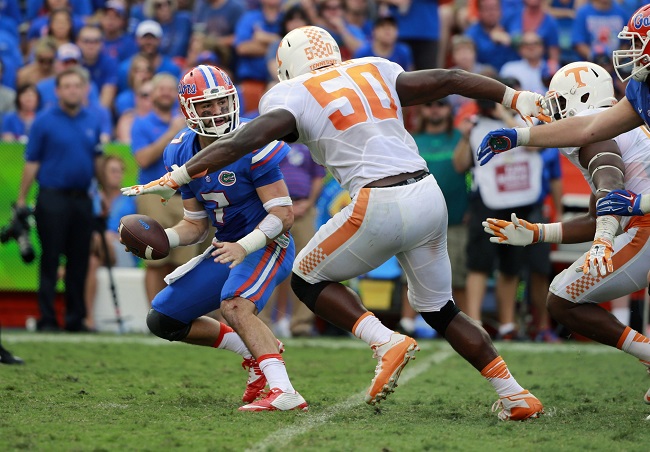
Honest assessment: Did Tennessee improve throughout the season?
Tennessee’s five-game winning streak to close the regular season might leave the impression the Volunteers improved drastically throughout 2015. Instead, small improvements allowed Tennessee to grow into a cohesive unit.
Here are three important factors that influenced Tennessee’s improvement throughout the 2015 season:
HEALTH
LB/DL Curt Maggitt’s season-ending hip injury in the Volunteer’s second game of the season against Oklahoma completely changed Tennessee’s 2015 trajectory. Before Maggitt’s injury, the Vols had one of the most fearsome pass rushing attacks in the nation. After his injury, the Vols pass rush was ineffective, accounting for only four sacks in Tennessee’s next four games (three of those sacks came against Florida’s patchwork offensive line).
In the wake of Maggitt’s injury, Tennessee’s other defensive linemen needed to find a way to step up and make plays. But that didn’t happen until Tennessee’s seventh game of the season against Alabama when the Vols sacked Alabama QB Jake Coker five times. Tennessee DL Corey Vereen had two sacks in that game, the first time that a player lined up on the opposite side of star DE Derek Barnett had come up with a sack since Maggitt’s injury.
In Tennessee’s next five games after its loss to Alabama, the Vols defense accounted for 12 more sacks — a massive improvement from the first half of Tennessee’s 2015 season. The main reason for Tennessee’s improved pass rush was the development of Vereen. As a result of the junior’s progress, Vereen took some of the opposing offensive lines’ attention away from Barnett which allowed both of them to be more dynamic pass rushers.
On Tennessee’s offensive line, guard Jashon Robertson dealt with injuries for most of the season. But in Tennessee’s past two games in which Robertson was healthy, the Vols offensive line showed significant signs of improvement. Tennessee didn’t give up a sack against Missouri or Vanderbilt — two of the SEC’s stingiest defenses. The Vols also had some of their best games running the football when Robertson was in the starting lineup, including 248 rushing yards against Missouri and 331 rushing yards against Vanderbilt.
EXPERIENCE
Another factor influencing Tennessee’s improvement during the second half of the season was the development of players who hadn’t played much. True freshman LB Darrin Kirkland Jr. grew into his role as a leader on Tennessee’s defense. He had 60 tackles, including five for loss, two sacks and five quarterback hurries.
CB Malik Foreman also grew more confident as the season progressed. Foreman was forced into the starting lineup at nickel when sophomore CB Rashann Gaulden fractured his foot in preseason camp, and opponents frequently picked on Foreman during the first half of the season. But he finally looked comfortable toward the end of the season. Against South Carolina, Foreman did an excellent job covering Gamecocks WR Pharoh Cooper, who only had four receptions for 47 yards. He also forced the game-preserving fumble in the final minutes.
CONFIDENCE
Tennessee’s ability to overcome a 21-point deficit in its 38-31 win over Georgia gave it the confidence it needed to finish the second half of the season on a high note. Before that victory, Tennessee had suffered agonizing losses to Oklahoma, Florida and Arkansas. But the Vols’ win over Georgia gave them confidence they could win close games.
Tennessee’s confidence continued to grow after a solid performance in its loss to Alabama, and took flight during its 53-21 dismantling of Kentucky.
